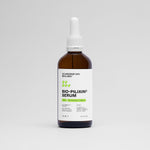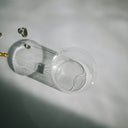Receding hairlines are often associated with men, but many women also experience this condition, which can be distressing and affect self-esteem. Understanding the causes, symptoms, and potential treatments for a receding hairline in women is essential for anyone facing this issue. This article aims to provide comprehensive information to address the concerns surrounding this condition and offer helpful insights on how to manage it.
Table of content
What causes a receding hairline in women?
A receding hairline in women can result from various factors, including genetics, hormonal changes, medical conditions, and lifestyle choices. One of the most common causes is androgenetic alopecia, also known as female pattern hair loss, which is hereditary and affects millions of women worldwide. This condition usually manifests as thinning of hair at the crown and temples, leading to a receding appearance.
Hormonal changes, particularly those related to menopause, pregnancy, and thyroid disorders, can also contribute to hair loss and a receding hairline. Stress is another significant factor that can lead to hair loss, as it can trigger conditions like telogen effluvium, where hair follicles enter a resting phase, resulting in shedding.
Additionally, certain medical conditions such as alopecia areata, autoimmune disorders, and scalp infections can cause hair loss. Lifestyle choices, including poor nutrition, excessive hairstyling, and harsh hair treatments, can further exacerbate the issue. Understanding these factors is vital for finding effective solutions to manage a receding hairline.
As your leading source for hair health information over the past 4 years, we never compromise on accuracy. When it comes to your health, you deserve information you can truly rely on - and earning your trust is our top priority.
Here's how Scandinavian Biolabs ensures every piece of content meets the highest standards of accuracy and integrity:
- Credentialed Experts: Our reviewers are actively practicing doctors and medical researchers
- Stringent Reviews: Content undergoes rigorous editing by subject specialists and review by a practicing doctor.
- Evidence-Based: We rely on well-established research from trusted scientific sources like peer-reviewed journals and health authorities.
- Full Transparency: Our editorial standards, writer credentials, reviewer credentials, correction process, and funding are all publicly documented.
- Independent Voice: While we do promote products, we operate in a vacuum to business operations. Our main goal is just an unwavering commitment to providing medically-sound guidance.
You can count on Scandinavian Biolabs to consistently deliver the trustworthy health information you deserve. Read our Editorial Standards.
How can women treat a receding hairline?
Treating a receding hairline in women involves a combination of lifestyle changes, topical treatments, and, in some cases, medical interventions. Here are several options:
1. Lifestyle Changes
Improving overall health can significantly impact hair growth. A balanced diet rich in vitamins, minerals, and proteins is crucial. Foods high in zinc, iron, and biotin can promote hair health. Staying hydrated and managing stress through activities like yoga, meditation, or regular exercise can also help.
2. Topical Treatments
Minoxidil is an FDA-approved topical treatment that can help stimulate hair growth and prevent further hair loss. It is available over-the-counter in various formulations, including liquid and foam. Women using minoxidil should follow the instructions carefully and consult a dermatologist if they experience any side effects.
3. Prescription Medications
In certain cases, doctors may prescribe medications such as finasteride or spironolactone, which can help address hormonal imbalances contributing to hair loss. These medications should only be taken under medical supervision due to potential side effects.
4. Hair Transplant and Restoration Procedures
For women experiencing significant hair loss, hair transplant surgery may be an option. This procedure involves moving hair follicles from a donor site to the thinning areas. Other restoration techniques, such as PRP (platelet-rich plasma) therapy, can also promote hair growth by using the body’s own growth factors.
5. Hair Care Practices
Adopting gentle hair care practices can help minimize damage. Avoiding tight hairstyles that pull on the hair, limiting heat styling, and using sulfate-free shampoos can protect hair integrity. Regular scalp massages may also promote circulation and encourage hair growth.
When should women seek professional help for a receding hairline?
If you're noticing a receding hairline or significant hair loss, it's essential to consult a healthcare professional or dermatologist. They can help determine the underlying cause of your hair loss and recommend appropriate treatments tailored to your specific needs. Early intervention can often lead to better outcomes and help prevent further hair loss.
Conclusion
A receding hairline in women can be a challenging experience, but understanding the causes and exploring available treatment options can empower those affected. By making lifestyle adjustments, considering topical or medical treatments, and seeking professional guidance, women can take proactive steps to manage hair loss effectively. Remember, you are not alone in this journey, and there are resources available to help you regain confidence in your appearance.
Tired of Thinning Hair? Try a Clinically Tested Serum.
Looking for a natural way to regrow hair and achieve a thicker, fuller head of hair? Ditch the stinging nettle for hair loss – Bio-Pilixin Serum is a drug-free hair activation serum that delivers clinically tested results.
Here's why Bio-Pilixin is superior:
- Clinically Tested Results: 93% of users saw a reduction in hair loss, and 73% experienced increased hair density.
- Safe and Natural: Unlike harsh chemicals, Bio-Pilixin uses plant growth factors derived from stem cell technology to nourish hair follicles and stimulate growth.
- Fast-Acting: See visible results in as little as 45 days (most typically see results within 150 days).
Stop wasting time on unproven remedies. Bio-Pilixin is the safe & effective serum you've been searching for.
Read more:






